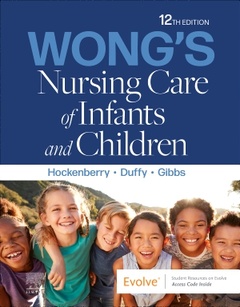Description
Wong's Nursing Care of Infants and Children (12th Ed.)
Author: Hockenberry Marilyn J.
Coordinators: Duffy Elizabeth A., Gibbs Karen
Language: English
Subject for Wong's Nursing Care of Infants and Children:
Keywords
<; P>; Pediatric Nursing; Wong's; Nursing Care of Infants and Children<; /P>
1472 p. · Paperback
Description
/li>Contents
/li>
Provide quality nursing care through each stage of child development! Wong's Nursing Care of Infants and Children, 12th Edition uses an easy-to-follow, family-centered approach to describe the care of children at each age and stage of development. The book begins with a discussion of the influences on and assessment of child health, then provides chapters on child health promotion and health problems - all organized by age groups and body systems. Up-to-date, evidence-based information helps you develop critical thinking skills along with the sensitivity needed to become a compassionate, caring pediatric nurse. Written by a team of experts led by Marilyn J. Hockenberry, Wong's continues to be the leading text in pediatric nursing.
- Focus on family-centered care emphasizes the role and influence of the family in child health and illness with a separate chapter and Family-Centered Care boxes.
- Full-color drawings and photographs reflect the latest in nursing care.
- Nursing Care Guidelines boxes offer clear, step-by-step instructions for interventions in a variety of situations and conditions, and Nursing Care Plan boxes included expected patient outcomes and rationales for nursing interventions.
- Nursing Tips include helpful hints and practical, clinical information.
- Translating Evidence into Practice and Applying Evidence to Practice boxes help you apply research to improve the outcomes of nursing care.
- Atraumatic Care boxes contain techniques for care that manage pain, discomfort, or stress, along with approaches to promote self-esteem and prevent embarrassment.
- Emergency Treatment boxes serve as a quick reference for interventions in critical situations.
- Cultural Considerationsand Cultural Competence content provides tips from clinical experts.
- Community and Home Health Considerations boxes address issues such as increasing immunization rates, decreasing smoking among teens, and preventing lead poisoning.
- Drug Alerts highlight important drug-related information for safe, appropriate care.
- Nursing Alerts call out critical considerations such as key assessment data, risk factors, and danger signs that must be considered in providing care.
- Research Focus boxes emphasize research with concise reviews of important evidence.
- NEW! Updated content reflects the objectives of Healthy People 2030, and updates and revisionsare made to each chapter.
- NEW! New Next Generation NCLEX® (NGN)examination-style questions are included in all chapters to promote critical thinking.
- NEW! NGN-style unfolding case studies replace nursing care plans in disease-focused chapters.
- NEW! More information on emerging viruses includes the latest evidence on COVID-19 in children.
- NEW! Updated immunization content is included in the Infectious Diseases chapter.
- NEW! More information on mental health issues of the school-age child is added.
- NEW! More information on vaping and smoking covers their impact on adolescents.
- NEW! More information on preventing obesity is included, as well as updates on hypertension guidelines and other chronic diseases of childhood.
- NEW! Updated figures and illustrations better reflect the diversity of families.
1 Perspectives of Pediatric Nursing
2 Family, Social, Cultural, and Religious Influences on Child Health Promotion
3 Hereditary Influences on Health of the Child and Family
SECTION II Childhood and Family Assessment
4 Communication and Physical Assessment of the Child and Family
5 Pain Assessment in Children
6 Childhood Communicable and Infectious Diseases
SECTION III Family-Centered Care of the Newborn
7 Health Promotion of the Newborn and Family
8 Health Problems of Newborns
9 The High-Risk Newborn and Family
SECTION IV Family-Centered Care of the Infant
10 Health Promotion of the Infant and Family
11 Health Problems of the Infant
SECTION V Family-Centered Care of the Toddler and Preschooler
12 Health Promotion of the Toddler and Family
13 Health Promotion of the Preschooler and Family
14 Health Problems of Early Childhood, 442
SECTION VI Family-Centered Care of the School-Age Child
15 Health Promotion of the School-Age Child and Family
16 Health Problems of the School-Age Child
SECTION VII Family-Centered Care of the Adolescent
17 Health Promotion of the Adolescent and Family
18 Health Problems of the Adolescent
SECTION VIII Family-Centered Care of the Child with Special Needs
19 Impact of Complex Chronic Illness, Disability, or End-of-Life Care on the Child and Family
20 Impact of Cognitive or Sensory Impairment on the Child and Family
SECTION IX The Child Who Is Hospitalized
21 Family-Centered Care of the Child During Illness and Hospitalization
22 Pediatric Nursing Interventions and Skills
SECTION X Childhood Nutrition and Elimination Problems
23 The Child With Fluid and Electrolyte Imbalance
24 The Child With Genitourinary Dysfunction
25 The Child With Gastrointestinal Dysfunction
SECTION XI Childhood Oxygenation Problems
26 The Child With Respiratory Dysfunction
SECTION XII Childhood Blood Production and Circulation Problems
27 The Child With Cardiovascular Dysfunction
28 The Child With Hematologic or Immunologic Dysfunction
SECTION XIII Childhood Regulatory Problems
29 The Child With Cancer
30 The Child With Cerebral Dysfunction
31 The Child With Endocrine Dysfunction
SECTION XIV Childhood Physical Mobility Problems
32 The Child With Integumentary Dysfunction
33 The Child With Musculoskeletal or Articular Dysfunction
34 The Child With Neuromuscular or Muscular Dysfunction
Index
These books may interest you

Maternal-Child Nursing 151.99 €



